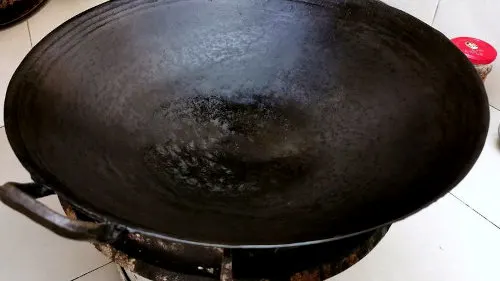My cast-iron wok has served our family for over five decades.
It’s more than a wok. It is our diary. It reminds me of my childhood years, frying noodles before going to school.
It’s like a film roll, flashing out endless footage, depicting moments in different phases of our life.
It’s more than 50 years now, and it still performs its duty diligently like a faithful servant.
What a remarkable wok.
As the owner of the faithful wok, it is my responsibility to take care of him to the best of my ability.
Fortunately, it is a beast that can be tamed easily. All I need is to season my trusted wok regularly.
I will explain how to season the wok in this article. But first thing first, we don’t use salt and pepper to season the wok. The intention is not to add flavor but to prevent any food morsels from sticking to the wok surface while cooking.

Note: This post may contain affiliate links. Please read my privacy policy for more info. I may receive commissions for purchases made through links in this post. As an Amazon Associate, I earn from qualifying purchases.
1. Why should you use a seasoned wok instead of a non-stick pan?
The main goal to season a wok is to make it non-stick. However, can’t we use a non-stick pan for cooking and save all the trouble to season a wok?
Here are the main reasons, and you should already be aware if you are an experienced cook:
- A wok is much larger than any non-stick pan. Therefore, it is more convenient to stir-fry any food without worrying that it will fall off from the edge while you stir and flip during stir-frying.
- There is no worry about the safety of using a cast iron wok while applying high heat. There are still some concern of using non-stick pan over high heat.
- Cast iron wok has a higher heat capacity. If you heat a cast iron wok and remove it from heat, it is still warm after half an hour! This property makes it ideal for stir-frying.
Therefore, you should get a wok if you often stir-fry in your kitchen. Of course, you may want to get a cast iron wok or a stainless steel wok. But my advice is to get a cast iron wok, and you will not regret it.
2. The science behind seasoning a wok
Most of us only want to know how to make the wok non-stick. However, it is worth understanding the science behind the scene. Here is the summary:
- When you cook, the food in the wok will tend to bond to the surface of the wok, causing it to stick. This happening is especially significant for food with high protein, such as meat and egg. For the same reason, vegetables are less likely to stick as the protein content is lower.
- You can avoid this by creating a non-stick layer on the wok surface, effectively separating the food from the wok surface. The food will therefore have no chance to stick to the wok.
- This method is called seasoning the wok. What is required is oil and high heat.
- After you apply some oil on the wok’s surface, heat the wok until the oil starts to smoke. At this point, the oil molecules will begin to bond to each other, forming a thin layer of a mega-complex called a polymer. This process will only happen when the oil is heated at its smoking point. The polymer layer is also more effectively formed by oil with high content of unsaturated fatty acid. e.g., canola, flaxseed, or grapeseed oil). This process is called polymerization. This thin layer is tough, impermeable which separates the food from the wok (or pan) and preventing it from sticking. It is also nonstick because it is hydrophobic, which means it expells water.
- However, this layer is not very secure and tends to detach from the wok. Therefore, you have to heat the wok to lay down this polymer onto the wok surface. This reaction can happen only when it is sufficiently hot, above the oil’s smoking point. Hot oil is less viscous and will fill up the wok’s spores and crevices and molecularly bond to the iron. Once this happened, the non-stick layer will firmly integrate with the wok.
Disclaimer: This information is what I have gathered from various sources and is meant for your reference. It may not be absolutely correct in the physical chemistry sense. However, as a pharmacist who is keen to find out the science of cooking, I try to explain what I understand in the simplest form. You are welcome to point out any mistakes in the comment section, and I will amend the information when necessary.
3. The simplest way to season the wok
Over the year, I have tried different ways to season the wok. These methods all work well, but I want to share the easiest and less messy way to season the wok.
Here are the steps:
- Clean the wok. If you are using a wok that has been used regularly, chances are it still has a thin layer of protection left from the previous seasoning. In this case, wash and clean it with a piece of cloth should be sufficient. However, if you have a new wok or rusty wok, you must scrub it clean with detergent and a scouring pad.
- Place the wok on the stove over medium heat.
- When the wok is completely dry, soak up half a piece of kitchen paper towel with oil.
- Apply a thin layer of oil on the entire surface of the wok.
- Turn on the smoke exhaust of the kitchen.
- Wait until the wok starts to smoke.
- Let it heat over the smoking point for twenty seconds.
- Turn off the stove, and allow the wok to cool.
- When it is cold enough to handle, rinse the wok with water. It is now ready to use.
- If you season a new wok or a rusted wok, repeat step 2-7 at least once or twice. Each time you repeat these steps, you add a thin non-stick coating on it. You will notice that the shinny layer will start to build on the surface.

4. The benefits of using this simple method
This method needs the least oil, a short heating time, and minimum smoke and smell compared to other methods.
Therefore, this method is handy if you live in an apartment, which you do not want to smoke the whole apartment and trigger the smoke alarm. It is also the cleanest and easiest way to do it.
You may wonder, is this simple effective? Watch the video in this article to find out the result of this method.
5. How to take care of a seasoned wok
This cast iron wok has served our family for five decades, and it has never even once required to re-season in any drastic way. I only need to maintain it by repeating the same process as mentioned above each time after using it. However, seasoning is not bulletproof. The non-stick layer will become thinner each time we cook something.
Here is my suggestion on how to maintain a good cast iron wok:
- First, do not use any harsh detergent to wash the wok, as it will wash away the oil that protects the wok. You can use a wok brush (made with bamboo), but a piece of wet cloth is equally good if it is not available. Second, avoid using and scouring pads to clean the wok.
- Avoid using the seasoned wok to steam and braise any food. Water will remove the non-stick coating if you use it as a steaming station. For the same reason, prolonged stewing and braising will also remove the non-stick coating.
- Acidic items such as lemon juice and vinegar can weaken the coating. Therefore, try to add any acidic ingredients to the food instead of directly onto the wok surface.

Related stir-fry recipe by using this wok
Bacon fried rice is not conventional Chinese-style fried rice. Crispy bacon and fresh button mushrooms are not common ingredients in the Chinese family. However, they work so well with rice when stir-fry over roaring heat, generating the signature wok aroma and bursting with the incredible flavor of bacon.
Bok choy stir-fry involves only a few ingredients. However, the best stir-fried bok choy needs high heat, which means a well-seasoned wok is crucial.

AC
Monday 6th of December 2021
You wrote about cast iron woks having good heat capacity. While that's true for thick western style cast iron cookware, your wok is the thinner Asian style wok. It's going to perform similarly to a carbon steel wok and not hold heat very well.
SC
Wednesday 4th of August 2021
I bought a carbon steel wok online. Can this method be used to season carbon steel woks?
KP Kwan
Wednesday 4th of August 2021
You can use the same method, but the initial (first time when new) may need to repeat a few times to get it ready. Thereafter, you can use the same method for maintenance.
Jimmy
Monday 26th of July 2021
Hi Mr Kwan,
What about those black woks sold in Chinese shops? What caused the black colour? Is it healthy? Is it non-stick? Does it need seasoning?
KP Kwan
Monday 26th of July 2021
If those black woks are heavy, most likely, that is cast iron wok. But, again, you can verify with the shop owner. The material of the wok has little relation to our health. Some people mentioned that there would be a trace amount of iron release into the food each time you cook with cast iron wok and is good for anemic people. However, I have not seen solid studies to support that statement.
Pall
Monday 26th of July 2021
I have a brand new iron wok which I bought from Penang, Malaysia. How do I make it black.
KP Kwan
Monday 26th of July 2021
If you have a new wok, you have to heat it until it smokes for a longer period. I assume it is the cast iron wok (black color). Then, do as mentioned in the article, but you need to repeat a few times. The surface will become shiny and smooth eventually. It takes a few times of heating up, then cool to get this shinning effect. After that, you can use it as usual and do the seasoning just once after each cooking.
KP Kwan
Monday 26th of July 2021
Hi, this is KP Kwan. I am happy to see you in this comment area, as you have read through my recipe. I am happy to reply to any questions and comments as soon as possible.